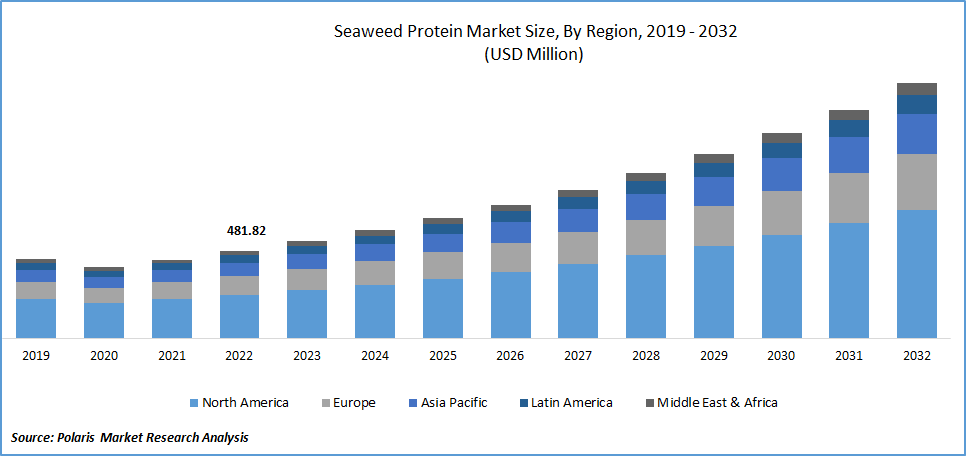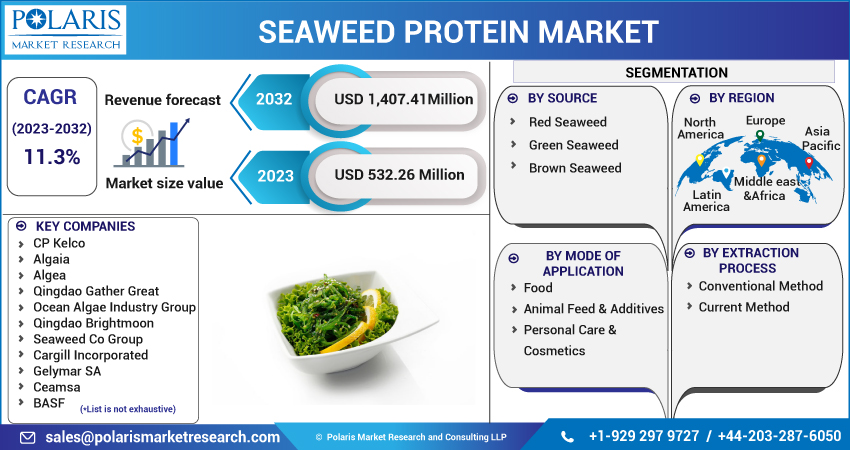
Seaweed Protein Market Share, Size, Trends, Industry Analysis Report
By Source (Red Seaweed, Green Seaweed, Brown Seaweed); By Mode of Application; By Extraction Process; By Region; Segment Forecast, 2023 - 2032
- Published Date:Jun-2023
- Pages: 111
- Format: PDF
- Report ID: PM2123
- Base Year: 2022
- Historical Data: 2019-2021
Report Outlook
The global seaweed protein market was valued at USD 481.82 million in 2022 and is expected to grow at a CAGR of 11.3% during the forecast period. As the global population continues to grow, the demand for protein is also increasing. However, traditional sources of protein such as meat, eggs, and dairy are becoming increasingly expensive and environmentally unsustainable. By 2050, there are projected to be 9.7 billion people on Earth; in order to keep up with this expansion, researchers predict that food production will need to rise by 70%. This will fuel the growth and demand for the Seaweed protein market in upcoming years.

To Understand More About this Research: Request a Free Sample Report
The growing hunger crisis is fueling the growth of the seaweed protein market as consumers and food manufacturers seek out sustainable and nutritious sources of protein. Almost 820 million people worldwide lack access to sufficient food, and since 2015, the number of undernourished individuals has been rising for the first time in decades. This will create wide range of opportunities for growth and demand for the market in coming years.
The growth of the seaweed protein market is also being driven by the increasing demand for plant-based diets. Consumers are increasingly looking for plant-based alternatives to meat and dairy products, and seaweed protein is an attractive option. Plant-based foods that directly substitute animal products saw an increase in grocery sales of 12.1% to $1.3 billion in the 52 weeks ended July 31, 2021, and 53% over the previous two years. This will further drive the growth of the market.

For Specific Research Requirements, Request for a Customized Report
Industry Dynamics
Growth Drivers
Seaweed is a sustainable food source as it does not require fresh water or arable land to grow. It also absorbs carbon dioxide from the atmosphere, helping to reduce greenhouse gas emissions. There has been a growing demand for plant-based products in recent years, driven by concerns over animal welfare, environmental sustainability, and health. Seaweed protein is a plant-based alternative to animal-based proteins, making it an attractive option for consumers looking to reduce their consumption of animal products.
Innovations in processing technology have made it possible to extract protein from seaweed in a cost-effective manner. This has opened new opportunities for the use of seaweed protein in a variety of food and beverage products. Seaweed has long been a staple in Asian cuisine, and the growing popularity of Asian cuisine in the Western world has helped to drive the demand for seaweed-based products. Many governments around the world are supporting the development of the seaweed industry as a sustainable food source. This has led to increased investment in seaweed farming and processing, which is driving the growth of the seaweed protein market.
Report Segmentation
The market is primarily segmented based on source, mode of application, extraction process and region.
|
By Source |
By Mode of Application |
By Extraction Process |
By Region |
|
|
|
|
To Understand the Scope of this Report: Speak to Analyst
Red Seaweed segment is expected to witness the fastest growth
Red Seaweed segment is projected to witness higher growth in upcoming years as has a high protein content, making it an attractive source of protein for the food and beverage industry. It contains all nine essential amino acids required for human health, making it a complete protein source. It can be used in a wide range of applications, including in food and beverage products, dietary supplements, and cosmetics. Its versatility makes it an attractive ingredient for manufacturers looking to develop new products.
Red seaweed is also known for its health benefits, including its ability to reduce inflammation, lower cholesterol levels, and improve heart health. These health benefits make it an attractive ingredient for health-conscious consumers. It is a sustainable and environmentally friendly ingredient. It grows quickly and does not require fertilizers or pesticides, making it a low-impact crop.
Food segment accounted for the largest market share in 2022
Food segment is projected to witness the largest market share throughout the forecast period. The growth of the market is increasing demand for plant-based protein sources such as seaweed protein, particularly red seaweed protein, is a high-quality plant-based protein that can be used in a variety of food products, including snacks, baked goods, and meat alternatives.
The sustainable nature of seaweed production is also a driving factor in the food segment. Seaweed farming requires minimal land, water, and other resources compared to traditional protein sources, and it can help mitigate the environmental impact of food production. The increasing demand for plant-based protein sources, the nutritional and functional properties of seaweed protein, the popularity of Asian cuisine, and the sustainability of seaweed production are all factors contributing to the growth of the seaweed protein market in the food segment.
Convention Method segment is expected to hold the significant revenue share
Conversation method segment is anticipated to hold a significant revenue share of the market and is likely to continue its significant growth throughout the projected period. This allows for the production of high-quality seaweed proteins that are suitable for a range of applications in the food industry. These proteins can be used as a plant-based alternative to animal-based proteins, which are associated with a range of environmental and ethical concerns.
Seaweed protein is also considered to be highly sustainable, as seaweed is a fast-growing and renewable resource. This can increase the efficiency of seaweed protein production. Traditionally, seaweed has been harvested and dried before being processed into a protein-rich powder. However, this method is time-consuming and labor-intensive. The conversion extraction process allows for the production of protein-rich extracts directly from fresh seaweed, reducing the processing time and increasing the yield of protein.
The demand in Asia Pacific is projected to witness higher growth
Asia Pacific is projected to witness higher growth in upcoming years. Seaweed is an important ingredient in Asian cuisine and has been traditionally consumed in many Asian countries for centuries. As a result, there is a high level of familiarity and acceptance of seaweed as a food ingredient in the region, which is expected to drive demand for seaweed protein as a plant-based alternative to animal-based protein sources. Seaweeds now form a crucial component of the coastal environment that supports aquatic life. They were consumed as food in a number of Asian nations, but in India they are only used to make hydrocolloids. This will drive the growth of the market in the coming future.
North America is projected to have the largest revenue share throughout the forecast period. This region has a well-established food industry with a high demand for protein-rich ingredients. Seaweed protein is a valuable ingredient for many food products, including meat alternatives, dairy alternatives, and snack products, among others. The established food industry in North America provides a strong market for seaweed protein, which is expected to drive its growth in the region. The increasing popularity of plant-based diets in North America is driving the demand for plant-based protein products, including seaweed protein. This is driven by various factors, including health and wellness trends, environmental concerns, and ethical considerations.
Competitive Insight
Some of the major players operating in the global market include CP Kelco, Algea, Qingdao Brightmoon Seaweed, Cargill, Gelymar, Ceamsa, BASF, Irish Seaweed, Dupont Nutrition and Biosciences, Compo Expert, Beijing Leili Agricultural, Groupe Roullier, and Acadian Seaplants.
Recent Developments
- In January 2023, BASF and Cargill announced the addition of the US to their current agreement for the development and sale of feed enzymes as part of their extended partnership.
- In November 2022, Ingredient powerhouses CP Kelco & Chr. Hansen is happy to offer clients a collaboration that combines their experience & solutions.
Seaweed Protein Market Report Scope
|
Report Attributes |
Details |
|
Market size value in 2023 |
USD 535.26 million |
|
Revenue Forecast in 2032 |
USD 1,407.41 million |
|
CAGR |
11.3% from 2023– 2032 |
|
Base year |
2022 |
|
Historical data |
2019– 2021 |
|
Forecast period |
2023– 2032 |
|
Quantitative units |
Revenue in USD million and CAGR from 2023 to 2032 |
|
Segments Covered |
By Source, By Mode of Application, By Extraction Process, By Region |
|
Regional scope |
North America, Europe, Asia Pacific, Latin America; Middle East & Africa |
|
Key Companies |
CP Kelco, Algaia, Algea, Qingdao Gather Great Ocean Algae Industry Group, Qingdao Brightmoon Seaweed Co Group, Cargill Incorporated, Gelymar SA, Ceamsa, BASF, Irish Seaweed, Dupont Nutrition and Biosciences, Compo Expert Group, Beijing Leili Agricultural Co, Groupe Roullier and Acadian Seaplants. |
FAQ's
key companies in Seaweed Protein Market are CP Kelco, Algea, Qingdao Brightmoon Seaweed, Cargill, Gelymar, Ceamsa, BASF, Irish Seaweed.
The global seaweed protein market expected to grow at a CAGR of 11.3% during the forecast period.
The Seaweed Protein Market report covering key segments are source, mode of application, extraction process and region.
key driving factors in Seaweed Protein Market are Growth in consumer awareness regarding the helth benefits of seawood protin-based product.
The global seaweed protein market size is expected to reach USD 1,407.41 million by 2032.
